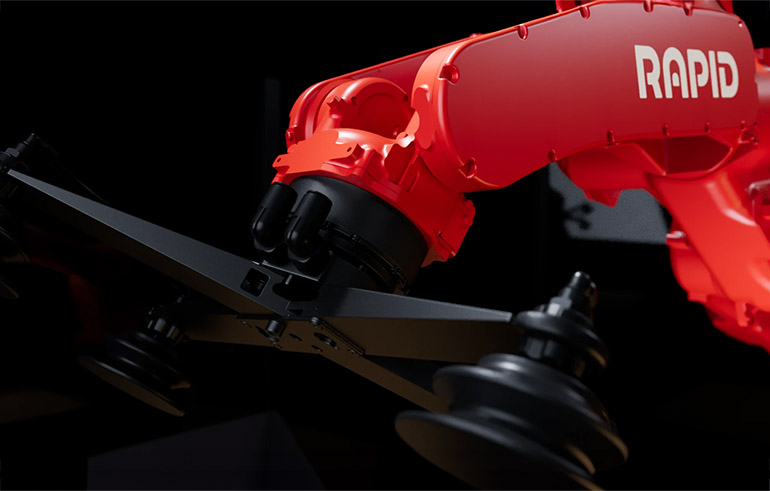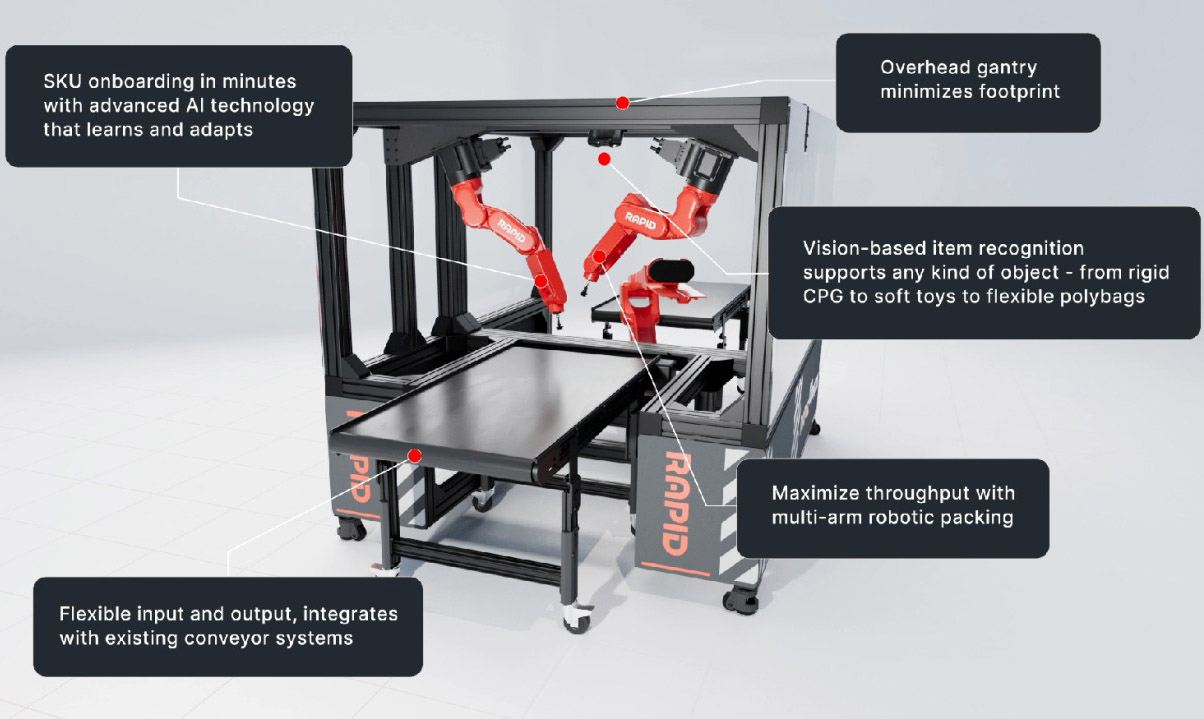|
Listen to this article  |

Rapid iD uses 3D vision and generative AI to quickly identify new objects. Source: Rapid Robotics
Many companies are racing to apply the latest advances in artificial intelligence to robotics. Rapid Robotics announced Rapid iD this year. The system uses generative AI, computer vision and machine learning to enable robotic arms to pick up, inspect and place objects “with 100 percent certainty in end-of-line and logistics scenarios.”
Last month, the San Francisco-based company promoted Kimberly Losey from chief growth officer to CEO, while founder Jordan Kretchmer moved to executive chairman.
“We founded Rapid Robotics in 2019 with a vision to solve the labor shortage and revitalize the American supply chain by delivering adaptive and scalable automation solutions in record time and at record low cost,” Kretchmer said at the time.
“Kim shares my passion for building long-term partnerships with our customers and developing generative AI-powered solutions that deliver tangible value,” he added. “Today, Rapid is built on this inimitable foundation of cutting-edge adaptive technology, hands-on experience deploying hundreds of robots, and a genuine commitment to our partners.”
Losey brings a wide range of experience
Before becoming Chief Growth Officer and Chief Marketing Officer at Rapid Robotics, Losey was Director of Global Brand Marketing and Development at Hasbro. She has also served as Chief Marketing Officer at Modio, Entrepreneur at Mod Mogul, and Chief Marketing Officer at Autodesk.

Kimberly Losey, CEO of Rapid Robotics. Source: LinkedIn
“I first studied design and then realized that I really love running a business,” she said The Robot Report“It’s really exciting right now in robotics with the growth of AI.”
“I learned a lot more about manufacturing in the clothing and toy industries than I ever thought possible,” Losey recalls.
“I helped revive some brands like Monopoly and Transformers before the movies came out,” she said. “When I figured out how to make enough Optimus Primes for the holiday season, maybe that’s when my love of robotics began.”
At Modio, which was acquired by Autodesk, Losey focused on 3D printing and design and was responsible for a project involving a welding cell with two robotic arms in a cargo container.
“Because I understand both the digital and physical side of the engineering and business side, I can bring all of these different perspectives to our work at Rapid Robotics,” Losey said. “In 2022, I joined the company that was trying to solve the labor crisis and change the way industry traditionally uses robots. The process takes so long, is complicated, and lacks transparency.”
Rapid Robotics takes a journey from RaaS
Among the challenges faced by robotics startups is the need to keep pace with the expansion of their customer base, especially in the Robotics-as-a-Service (RaaS) model, where the supplier is responsible for managing and maintaining the machines.
“As our customers grew, the challenge was that we couldn’t keep up,” Losey said. “The technology we had wasn’t mature enough to solve their problems quickly.”
“We took a few steps back to reboot and looked at what I called the ‘robot hierarchy of needs,'” she explained. “The fundamental level is really about perception and manipulation. That’s what has kept so many consumer goods companies from using robots.”
“Manufacturing and supply chain applications are becoming increasingly complex, so we need robots that can adapt almost as well as humans,” Losey said. “If you think back to the toy industry, kids are brilliant in many ways, but they can’t always tell you what they want. Understanding what they’re not saying is where you get the greatest insights, and that’s like finding out what the customer needs.”
Rapid Robotics realized its customers wanted adaptive robots that could quickly complete tasks that weren’t rewarding for humans, she said. The company shifted its focus from RaaS to Rapid iD as a product that “combines robot performance with human instinct,” Losey said.
Rapid iD quickly learns objects to be manipulated
The Rapid iD Engine uses 3D image capture and generative AI to learn new objects and can adapt to them in less than two minutes, Rapid Robotics said. This enables optimized gripping and precision in pick-and-place operations, the company claimed.
“Simplicity is better than complexity,” Losey said. “We’re not just using AI as a solution to the problem, but we’re staying on top of new trends. Computer vision is much better today than it was 18 months ago. We’re developing our technology to take advantage of all these new AI models, specifically to better perceive and manipulate objects.”
Rapid Robotics has applied Rapid iD to single-part picking, packing, palletizing and depalletizing, and dynamic kitting. A subscription box, for example, might contain objects of wildly different sizes and stiffness in too many combinations for traditional approaches to work, Losey said.
“Generative AI gives us a kind of superpower that we can transfer to the robots,” she said. “At the same time, we need more contextualized data sets. I was talking to someone the other day, and his view was, ‘Look, I don’t need my robot to drive from A to B. And thread a needle and clean the windows.'”
While many other companies are working to make robots smarter with generative AI, Losey believes Rapid Robotics strikes the right balance between specificity and general-purpose automation.
“There are big market opportunities, but we’re not trying to reinvent the wheel, whether it’s the motion stack for robots or large language models,” she said. “Not everything has to be proprietary, and we’re taking an ensemble approach to identifying and grasping objects.”
Another differentiator is that Rapid iD is already on the market, Losey said.
“We have dozens and dozens of customers, from small contract manufacturers to Fortune 100 and top 10 companies worldwide, and they need solutions to these problems today,” she explained. “We also look at the five-year horizon and think about it in terms of the valuation we’re aiming for, but more importantly are the problems we’re solving for our customers.”

Rapid iD enables a packaging cell to handle everything from rigid cartons to flexible poly bags, according to Rapid Robotics. Source: Rapid Robotics
Smarter robots are easier to use than point or general solutions
Rapid Robotics still offers a RaaS option as well as CapEx (capital expenditure) pricing. The company’s customers want to be experts in logistics, not advanced robotics, Losey noted. Ease of use is important to Rapid Robotics, she added.
“They don’t have the resources to automate, and even the system integrators are so stretched right now,” Losey said. “How can we make robots as easy as buying a workbench at the hardware store? They need to be as seamless and foolproof as a 3D printer.”
“We have these important partnerships with our current customer base to deploy solutions like Rapid iD for kitting or packaging, and from that we know that the perception layer and the application layer are starting to blur a little bit,” she said. “That will create base models that give us a great opportunity to deliver what the market is asking for, rather than a totally generalized application.”
“We need the level of intelligence to keep up with the changes and modern demands in the logistics space,” Losey said. “We put that core on picking and placing objects and then looked at related tasks like packing things into boxes and palletizing those boxes. That forces us to have a platform mentality, not a point solution mentality.”
Rapid Robotics has demonstrated that it can detect and place stuffed animals on a conveyor belt at a rate of 800 per hour, offering potential for e-commerce, recycling and product returns, Losey said.
